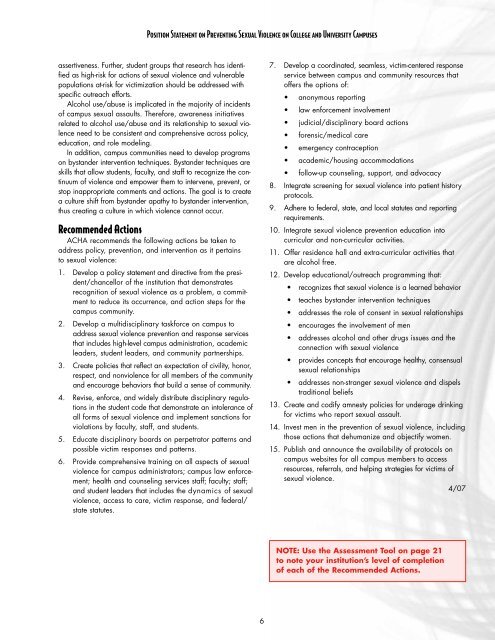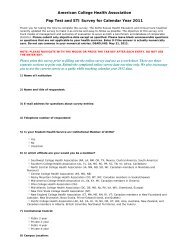Position Statement on Preventing <strong>Sexual</strong> <strong>Violence</strong> on <strong>College</strong> and University Campusesassertiveness. Further, student groups that research has identifiedas high-risk for actions <strong>of</strong> sexual violence and vulnerablepopulations at-risk for victimization should be addressed withspecific outreach efforts.Alcohol use/abuse is implicated in the majority <strong>of</strong> incidents<strong>of</strong> campus sexual assaults. Therefore, awareness initiativesrelated to alcohol use/abuse and its relationship to sexual violenceneed to be consistent and comprehensive across policy,education, and role modeling.In addition, campus communities need to develop programson bystander intervention techniques. Bystander techniques areskills that allow students, faculty, and staff to recognize the continuum<strong>of</strong> violence and empower them to intervene, prevent, orstop inappropriate comments and actions. The goal is to createa culture shift from bystander apathy to bystander intervention,thus creating a culture in which violence cannot occur.Recommended ActionsACHA recommends the following actions be taken toaddress policy, prevention, and intervention as it pertainsto sexual violence:1. Develop a policy statement and directive from the president/chancellor<strong>of</strong> the institution that demonstratesrecognition <strong>of</strong> sexual violence as a problem, a commitmentto reduce its occurrence, and action steps for thecampus community.2. Develop a multidisciplinary taskforce on campus toaddress sexual violence prevention and response servicesthat includes high-level campus administration, academicleaders, student leaders, and community partnerships.3. Create policies that reflect an expectation <strong>of</strong> civility, honor,respect, and nonviolence for all members <strong>of</strong> the communityand encourage behaviors that build a sense <strong>of</strong> community.4. Revise, enforce, and widely distribute disciplinary regulationsin the student code that demonstrate an intolerance <strong>of</strong>all forms <strong>of</strong> sexual violence and implement sanctions forviolations by faculty, staff, and students.5. Educate disciplinary boards on perpetrator patterns andpossible victim responses and patterns.6. Provide comprehensive training on all aspects <strong>of</strong> sexualviolence for campus administrators; campus law enforcement;health and counseling services staff; faculty; staff;and student leaders that includes the dynamics <strong>of</strong> sexualviolence, access to care, victim response, and federal/state statutes.7. Develop a coordinated, seamless, victim-centered responseservice between campus and community resources that<strong>of</strong>fers the options <strong>of</strong>:• anonymous reporting• law enforcement involvement• judicial/disciplinary board actions• forensic/medical care• emergency contraception• academic/housing accommodations• follow-up counseling, support, and advocacy8. Integrate screening for sexual violence into patient historyprotocols.9. Adhere to federal, state, and local statutes and reportingrequirements.10. Integrate sexual violence prevention education intocurricular and non-curricular activities.11. Offer residence hall and extra-curricular activities thatare alcohol free.12. Develop educational/outreach programming that:• recognizes that sexual violence is a learned behavior• teaches bystander intervention techniques• addresses the role <strong>of</strong> consent in sexual relationships• encourages the involvement <strong>of</strong> men• addresses alcohol and other drugs issues and theconnection with sexual violence• provides concepts that encourage healthy, consensualsexual relationships• addresses non-stranger sexual violence and dispelstraditional beliefs13. Create and codify amnesty policies for underage drinkingfor victims who report sexual assault.14. Invest men in the prevention <strong>of</strong> sexual violence, includingthose actions that dehumanize and objectify women.15. Publish and announce the availability <strong>of</strong> protocols oncampus websites for all campus members to accessresources, referrals, and helping strategies for victims <strong>of</strong>sexual violence.4/07NOTE: Use the Assessment Tool on page 21to note your institution’s level <strong>of</strong> completion<strong>of</strong> each <strong>of</strong> the Recommended Actions.6
<strong>Sexual</strong> <strong>Violence</strong> <strong>Prevention</strong>By David S. Lee, MPH, Lydia Guy, BA, and Brad Perry, MA<strong>Primary</strong> prevention involves developing comprehensive strategiesthat stop violence before initial perpetration or victimization,especially those that make community and society levelchanges. The best sexual violence prevention strategies combinethe socio-political analysis <strong>of</strong> the feminist anti-rape movementand the systematic approach to promoting healthy behaviorscentral to public health theory.<strong>Prevention</strong> work focused on college-age students is animportant element to any comprehensive strategy to preventsexual violence. From a primary prevention perspective,college-age men and women are at a developmental stagewhere lifelong behaviors are shaped. Young men and womenare continuing to learn how to perform their socially influencedgender roles, and how to act out their gender-based sexualscripts. Appropriately timed prevention strategies can reducefuture sexual violence.In this article, we will review the foundations <strong>of</strong> sexualviolence prevention work. Then we will explore the use <strong>of</strong>education sessions to prevent sexual violence, and thenreview more comprehensive strategies, such as communitymobilization, changing social norms, social marketing, andpolicy work.Foundations for Preventing <strong>Sexual</strong> <strong>Violence</strong>The foundation <strong>of</strong> efforts for preventing sexual violencecome from both the feminist movement and from empirical datafrom research on associated risk and protective factors. Feministtheory understands rape as a cultural phenomenon requiringinterventions beyond the personal and interpersonal. It is thefoundation <strong>of</strong> the anti-rape movement (Rozee & Koss, 2001).Feminist theory articulates sexual violence in the context <strong>of</strong> arape culture, a complex system <strong>of</strong> beliefs that encourages malesexual aggression and supports violence against women(Buchwald et al., 1993). Interpreting sexual violence as a foreseeableconsequence <strong>of</strong> rape culture has a pr<strong>of</strong>ound effect onsexual violence prevention strategies. <strong>Sexual</strong> violence is seenas a continuum <strong>of</strong> behaviors instead <strong>of</strong> an isolated, deviantact. Feminist models <strong>of</strong> sexual violence hold that it is notinevitable, and can be prevented by making changes to societalnorms surrounding sexuality, violence, gender, and oppression(hooks, 1989).Research has identified risk factors for individual victimization,such as being female and having experienced past sexualvictimization. Risk factors for individual perpetration includebeing male, having coercive sexual fantasies, hostility towardswomen, a history <strong>of</strong> childhood sexual victimization, growingup in an emotionally unsupportive family environment, andadherence to societal norms supportive <strong>of</strong> sexual violence,male superiority, and male sexual entitlement (Jewkes, Sen, &Garcia-Moreno, 2002). However, little is currently knownabout protective factors that may reduce vulnerability to victimizationand risk for perpetration, or environmental factors thatmay contribute to prevalence. Notwithstanding, promotingprotective factors and addressing negative social and environmentalcontributors are important components <strong>of</strong> a publichealth approach to prevent sexual violence (NCIPC, 2006).Preventing <strong>Sexual</strong> <strong>Violence</strong> Before It OccursOver the last 30 years, most anti-sexual violence effortshave been responses after the sexual violence or efforts to promoteawareness <strong>of</strong> sexual assault and resources available tosurvivors <strong>of</strong> sexual violence. To address sexual violence preventionin a truly comprehensive manner, strategies to prevent itsinitial perpetration and victimization (primary prevention) mustreach the same level <strong>of</strong> efficacy and adoption as programsthat respond to its consequences.Public health theory also advises that sexual violence preventionefforts be specific to an intentional audience. Audiencescan also be categorized by their likely role in an act <strong>of</strong> sexualviolence: as potential victims <strong>of</strong> the violence (Rozee & Koss,2001), as potential perpetrators <strong>of</strong> the violence (Clinton-Sherrod,et al., 2003), or as potential bystanders who have an opportunityto prevent or intervene in the act (Banyard, Plante, &Moynihan, 2004).Educational SessionsEducational sessions are perhaps the most commonly recognizedform <strong>of</strong> sexual violence prevention work, and thereare a wide variety <strong>of</strong> prevention curricula (see Morrison, et al.,2004 for a review). The goal <strong>of</strong> primary prevention educationsessions is to prevent first-time perpetration or victimizationby improving knowledge and attitudes that correspond to theorigins <strong>of</strong> sexual violence (such as adherence to societal normssupportive <strong>of</strong> sexual violence, male superiority, and male sexual7



![Final Program [5.4MB pdf] - American College Health Association](https://img.yumpu.com/49022356/1/190x245/final-program-54mb-pdf-american-college-health-association.jpg?quality=85)












